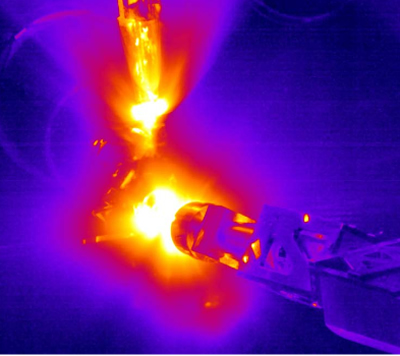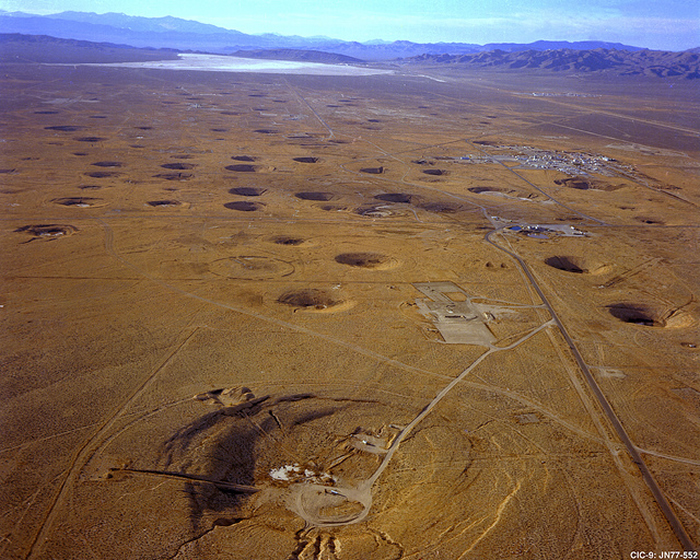NIF Experiments Support Warhead Life Extension
January 9, 2019
It was a normal morning for design physicist Madison Martin at LLNL. At 7:45 a.m., she settled into her classified workstation with a cup of tea to check the results of a numerical calculation she ran overnight.
If the calculations proved correct, the experiment she was designing on NIF would deliver the data her colleagues needed to verify that a refurbished nuclear warhead would perform as expected.
Martin is one of many physicists at LLNL whose careers are defined by the stockpile stewardship era—using modern experiments, historic test data, and high-performance computing to ensure the long-term viability of the U.S. deterrent without additional underground nuclear tests.
 The National Nuclear Security Administration maintains and enhances the safety, security, and effectiveness of the U.S. nuclear weapons stockpile without nuclear explosive testing. The W80-4 Life Extension Program is essential to enabling the NNSA to accomplish its mission to certify the effectiveness of the nation’s nuclear deterrent.
The National Nuclear Security Administration maintains and enhances the safety, security, and effectiveness of the U.S. nuclear weapons stockpile without nuclear explosive testing. The W80-4 Life Extension Program is essential to enabling the NNSA to accomplish its mission to certify the effectiveness of the nation’s nuclear deterrent. Martin was in kindergarten when the last nuclear test took place, and the nuclear weapon her colleagues are refurbishing entered the stockpile in 1982, long before she was born.
The experiment was one of the high energy density NIF experiments conducted in Fiscal Year 2018 in support of the W80-4 life extension program (LEP). The data acquired in those experiments are helping weapon designers at LLNL assess replacement options for aged materials in the W80 warhead, marking the successful completion of one of the 12 key objectives on the National Nuclear Security Administration (NNSA)’s “getting the job done” list of top priorities for FY18.
“People I talk with outside the Lab often think NIF only is used to research fusion energy,” Martin said. “We are weapon designers using NIF as a tool for stockpile stewardship. Ignition research is an important piece of that, but it’s not the only way we use NIF to support the stockpile. In order to certify that a refurbished device will work as expected, we need to examine the physics in detail. NIF makes that possible in ways that no other facility can.”
 NIF experiments are uniquely capable of informing and validating three-dimensional weapons-simulation computer codes that support the W80-4 LEP effort. This NIF experiment was aimed at developing a high-pressure strength measurement capability for plutonium.
NIF experiments are uniquely capable of informing and validating three-dimensional weapons-simulation computer codes that support the W80-4 LEP effort. This NIF experiment was aimed at developing a high-pressure strength measurement capability for plutonium. LLNL is the lead nuclear design agency for the W80-4 LEP. Some aged materials and components that need replacement cannot be produced exactly as they were originally manufactured. Researchers conduct extensive studies to evaluate whether various replacement options can be certified to be safe (won’t go off by accident), secure (can’t be set off without formal permissions) and effective (will work as designed) without having to conduct a full-scale explosive nuclear test of the system.
That’s where facilities like NIF come in.
NIF was funded, designed and developed to help replace the role underground nuclear tests played in maintaining the nuclear stockpile. The experiments conducted in support of the W80-4 LEP in FY18 were built on many years of development of experiment configurations and diagnostics.
“Hundreds of experiments led up to where we are today,” said Alan Wan, the deputy program director of the Weapon Physics and Design Program. “When the need came with the LEP, we were able to deliver quickly. We were able to get the job done.”
NIF provides access to the highest pressure and temperature regimes needed to assess weapon physics and material responses. In this case, physicists were able to use NIF to inform decisions about whether they could replace aged materials in the W80 without sacrificing the warhead’s safety, security, and effectiveness.
‘Cornerstone’ of Stockpile Stewardship
There are roughly four phases in a two-stage nuclear detonation. In the first “high explosives” phase, high explosives compress special nuclear material, creating a supercritical assembly. The “primary phase” comes next, when the supercritical assembly fissions and initiates fusion reactions, ultimately creating a burst of neutrons and x-ray energy. Those x rays travel from the weapon primary to the secondary in the third “energy transfer” phase. Finally, the weapon secondary produces energy, explosion, and radiation in the “secondary phase.”
While high explosives kick-start a nuclear detonation, the majority of a weapon’s energy output is produced in the high energy density (HED) state of the matter, where temperatures and pressures are equivalent to those found on the surface of the sun. In the absence of underground nuclear testing, HED experimental facilities like NIF are the only way to answer questions about matter under these extreme conditions.
 Subsidence craters resulting from underground atomic tests at Yucca Flat over areas 7 and 3 of the Nevada Test Site. Underground testing was halted by President George H.W. Bush in 1992. Credit: LANL
Subsidence craters resulting from underground atomic tests at Yucca Flat over areas 7 and 3 of the Nevada Test Site. Underground testing was halted by President George H.W. Bush in 1992. Credit: LANL “NIF has proven its worth to stockpile stewardship time and again,” said Michael Zika, associate program director in the Weapon Physics and Design Program. “Other platforms complement the data that NIF provides, but they cannot achieve the pressures and temperatures, or experimental repeatability, that NIF does. That’s what makes NIF a cornerstone of stockpile stewardship.”
In addition to the FY18 experiments in support of the W80-4 LEP, NIF is making significant contributions in a number of areas relevant to stockpile stewardship:
- Energy balance: Researchers used NIF to help solve a mystery about how energy flows in a nuclear detonation—euphemistically called “energy balance”—that eluded explanation for half a century. This breakthrough significantly advanced confidence in the accuracy of scientific assessments of the stockpile.
- Material properties: Researchers are using NIF to measure the phase, strength and equation-of-state of plutonium—perhaps the strangest and most enigmatic material on the periodic table—under previously unmeasured pressures and temperatures. These measurements are relevant to weapon physics and are expected to continue to pay dividends not only for certification of life-extended weapon systems, but also for the annual assessments that NNSA laboratories conduct to evaluate if the U.S. stockpile is aging acceptably.
- Survivability: Researchers are using NIF to produce radiation sources to evaluate how well U.S. weapons will be able to survive—and function as expected—after traversing evolving adversary missile defenses. Without the ability to survive, these weapons would be unable to hold targets at risk, rendering the deterrent ineffective.
Efforts to achieve fusion ignition at NIF have expanded the boundaries of scientific understanding. Physicists like Wan, Zika and Martin see the facility continuing to play a key role in helping them answer questions about how the stockpile is aging and how they might be able to extend its life.
“NIF enables us to use science to certify the performance and safety of replacement parts without resorting to full-scale nuclear testing,” Wan said. “NIF has proven its worth many times over, and I’m confident it will continue to play a key role as the stockpile ages and we’re asked to refurbish or replace warhead components.”
The FY18 experimental effort was led by LLNL scientist Amy Jenei. Contributors included Damien Swift, Andrea Kritcher, Natalie Kostinski, Brian Maddox, Martin, Heather Whitley, Phil Sterne, Joe Nilsen, Abbas Nikroo, Rich Seugling, Wan, Angela Cook and Korbie Le Galloudec.
“The entire NIF team, which encompasses hundreds of people in many different disciplines, are proud of the important contributions NIF is making to stockpile stewardship,” said NIF director Mark Herrmann. “These contributions include both critical data and opportunities to develop the next generation of stockpile stewards—people like Madison Martin and her colleagues.”
—Nolan O’Brien
More Information
“Extending the Life of a Workhorse Warhead,” Science & Technology Review, October-November 2018Follow us on Twitter: @lasers_llnl



